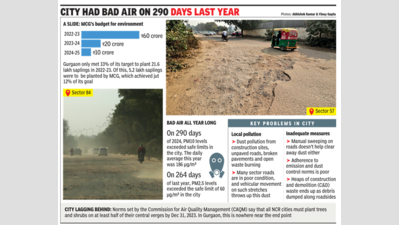
Gurgaon: Even as the city’s
air quality
continued to deteriorate over the years, MCG‘s budget for environmental work has seen a drastic reduction.
For the 2024-25 fiscal year, the budget stands at Rs 10 crore, a sharp decline from Rs 20 crore in 2023-24 and Rs 60 crore in 2022-23. As the city gears up for its municipal elections on March 2, air pollution has emerged as a critical issue for voters. Despite the urgent need for environmental action, MCG has struggled to make significant progress in mitigating pollution.
This reduction in funding has raised concerns among residents about the effectiveness of MCG’s efforts to combat air pollution and improving the quality of life in the city. As the election date approaches, candidates are expected to present detailed plans to address air quality issues. Voters are keenly watching to see which party will offer the most comprehensive solutions to ensure a healthier future for the city.
The results of the municipal elections will be announced on March 12 and the winning candidates will be tasked with implementing their proposed policies to combat air pollution and improve the quality of life for city’s residents.
The city’s air quality has been deteriorating, with 290 days in 2024 recording PM10 levels exceeding the safe limit. The average PM10 level for the year was 186 µg/m³, more than three times the National Ambient Air Quality Standards (NAAQS) limit of 60 µg/m³. PM10, which includes particles from industries, vehicles, waste burning and construction dust, poses severe health risks, including respiratory and cardiovascular diseases.
For over two-thirds of 2024, PM2.5 levels in the city also failed to meet national standards. Central Pollution Control Board reported that PM2.5 levels exceeded 60 µg/m³ on 264 days. The city has consistently struggled to meet these standards, with only 105 days in 2023 and 103 days in 2022 meeting the NAAQS standard. The situation was slightly better during the pandemic years due to lockdown restrictions, but the trend has been worsening over the years.
Max Hospital (Gurgaon) associate director — pulmonology, respiratory critical care & sleep medicine — Dr Neeraj Gupta said, “Broken roads and excessive dust in Gurgaon have been major contributors to respiratory problems throughout the year. The fine suspended particles from dust, construction and demolition (C&D) waste and waste burning remain in the air for long periods, leading to severe health issues.”
“Continuous exposure causes irritation in the nose, throat and airways, often triggering allergic reactions. Prolonged inhalation of these pollutants increases the risk of bronchitis, asthma and other chronic respiratory conditions. The burning of waste releases toxic pollutants, further aggravating lung infections and breathing difficulties. Poor air quality due to these factors significantly affects vulnerable groups, including children and the elderly, making respiratory health a growing concern in the region,” Gupta said.
The dust bowls — construction sites, unpaved roads, broken pavements, burning garbage — are local creations that drive the PM10 average up.
No amount of health warnings seems to work in triggering a civic response on a war footing from the govt and the city administration. Residents have voiced their concerns about the health impacts of poor air quality, including respiratory problems and aggravated asthma.
The city’s infrastructure issues, such as dust-covered trees and shrubs and construction waste, further exacerbate the problem. In every sector, there are multiple under-construction sites where debris is often lying in the open and where diesel-operated concrete mixers are frequently used. It isn’t uncommon to spot open waste burning in the residential areas of the city.
Commission for Air Quality Management (CAQM) has mandated that all NCR cities, including Gurgaon, plant trees and shrubs on at least half of their central verges by Dec 31, 2023.
However, the city appears to be far from achieving this goal, highlighting the ongoing challenges in mitigating air pollution.
As per the data, the target for the district was to carry out the plantation of 21,63,350 saplings in 2022-23. However, just 33% of the target has been achieved. This target was set after CAQM in 2022 framed a policy to improve air quality in Delhi-NCR. Similarly, MCG had a target of 5,25,000 saplings, out of which it achieved 12%.
With their dusty and uneven surfaces, city’s roads are among the thorniest challenges the city’s residents must navigate every day. While the majority of the sector roads are in poor condition, dust from nearby sources often tends to get deposited on the roads. This dust is susceptible to re-suspension, mainly due to vehicular movement. There are areas in the city where sweeping is still carried out manually, which keeps the dust in the same area.
Rapidly urbanising localities and construction activity generate enormous amounts of dust. Sanmita Sengupta, a resident of Sector 31, said, “A significant portion of construction and demolition waste (C&D) can be recycled and reused, but large volumes end up as debris dumps along roadsides.”
Sengupta said, “Construction sites, which are one of the major reasons for air pollution in sectors, need better monitoring of adherence to emission and dust control norms as well as debris management.” Also, dust management from C&D activities and greening measures are needed. While tighter regulations, standards and compliance mechanisms can ensure widespread adoption of emissions control systems in the industry sector, integration of urban planning and urban design mandates can leverage infrastructure spending of the private sector, including that of construction bodies, developers and transport providers.
Abhishek Bharadwaj, a resident of Sector 56, said, “Most of the sector roads in Gurgaon are marred by dust and a lack of greenery, contributing to the city’s air pollution woes. The internal roads are broken at several stretches and when vehicles ply on these broken roads, dust doesn’t settle but keeps dispersing in the area.”

